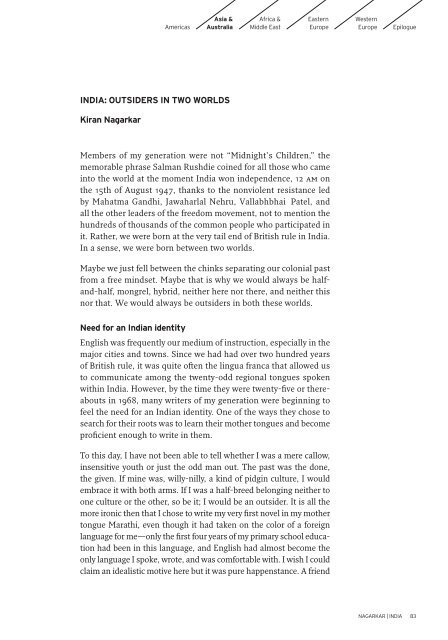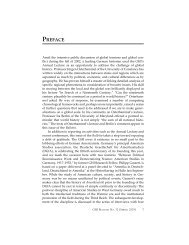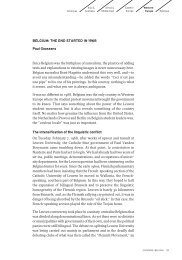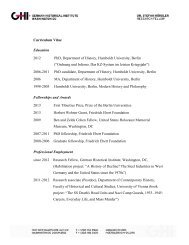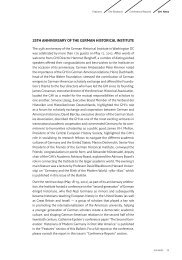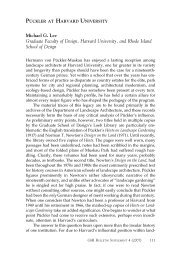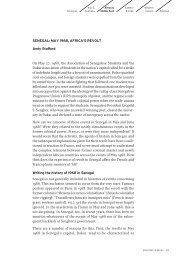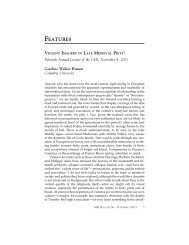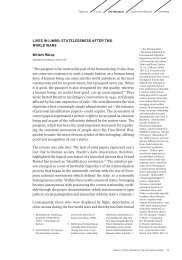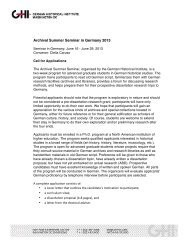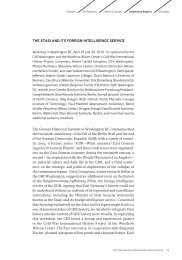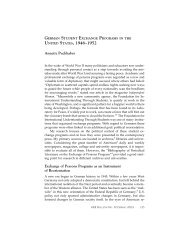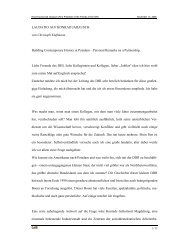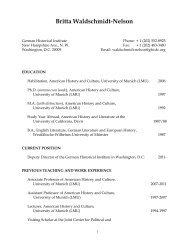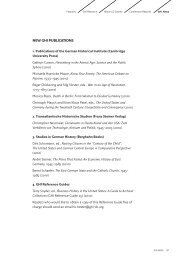INDIA: OUTSIDERS IN TWO WORLDS Kiran Nagarkar Need for an ...
INDIA: OUTSIDERS IN TWO WORLDS Kiran Nagarkar Need for an ...
INDIA: OUTSIDERS IN TWO WORLDS Kiran Nagarkar Need for an ...
You also want an ePaper? Increase the reach of your titles
YUMPU automatically turns print PDFs into web optimized ePapers that Google loves.
Americas<br />
Asia &<br />
Australia<br />
Africa &<br />
Middle East<br />
Eastern<br />
Europe<br />
Western<br />
Europe<br />
Epilogue<br />
<strong><strong>IN</strong>DIA</strong>: <strong>OUTSIDERS</strong> <strong>IN</strong> <strong>TWO</strong> <strong>WORLDS</strong><br />
<strong>Kir<strong>an</strong></strong> <strong>Nagarkar</strong><br />
Members of my generation were not “Midnight’s Children,” the<br />
memorable phrase Salm<strong>an</strong> Rushdie coined <strong>for</strong> all those who came<br />
into the world at the moment India won independence, 12 am on<br />
the 15th of August 1947, th<strong>an</strong>ks to the nonviolent resist<strong>an</strong>ce led<br />
by Mahatma G<strong>an</strong>dhi, Jawaharlal Nehru, Vallabhbhai Patel, <strong>an</strong>d<br />
all the other leaders of the freedom movement, not to mention the<br />
hundreds of thous<strong>an</strong>ds of the common people who participated in<br />
it. Rather, we were born at the very tail end of British rule in India.<br />
In a sense, we were born between two worlds.<br />
Maybe we just fell between the chinks separating our colonial past<br />
from a free mindset. Maybe that is why we would always be half<strong>an</strong>d-half,<br />
mongrel, hybrid, neither here nor there, <strong>an</strong>d neither this<br />
nor that. We would always be outsiders in both these worlds.<br />
<strong>Need</strong> <strong>for</strong> <strong>an</strong> Indi<strong>an</strong> identity<br />
English was frequently our medium of instruction, especially in the<br />
major cities <strong>an</strong>d towns. Since we had had over two hundred years<br />
of British rule, it was quite often the lingua fr<strong>an</strong>ca that allowed us<br />
to communicate among the twenty-odd regional tongues spoken<br />
within India. However, by the time they were twenty-five or thereabouts<br />
in 1968, m<strong>an</strong>y writers of my generation were beginning to<br />
feel the need <strong>for</strong> <strong>an</strong> Indi<strong>an</strong> identity. One of the ways they chose to<br />
search <strong>for</strong> their roots was to learn their mother tongues <strong>an</strong>d become<br />
proficient enough to write in them.<br />
To this day, I have not been able to tell whether I was a mere callow,<br />
insensitive youth or just the odd m<strong>an</strong> out. The past was the done,<br />
the given. If mine was, willy-nilly, a kind of pidgin culture, I would<br />
embrace it with both arms. If I was a half-breed belonging neither to<br />
one culture or the other, so be it; I would be <strong>an</strong> outsider. It is all the<br />
more ironic then that I chose to write my very first novel in my mother<br />
tongue Marathi, even though it had taken on the color of a <strong>for</strong>eign<br />
l<strong>an</strong>guage <strong>for</strong> me—only the first four years of my primary school education<br />
had been in this l<strong>an</strong>guage, <strong>an</strong>d English had almost become the<br />
only l<strong>an</strong>guage I spoke, wrote, <strong>an</strong>d was com<strong>for</strong>table with. I wish I could<br />
claim <strong>an</strong> idealistic motive here but it was pure happenst<strong>an</strong>ce. A friend<br />
NAGARKAR | <strong><strong>IN</strong>DIA</strong> 83
mentioned that he had been asked to be the guest editor of a magazine<br />
called Abhiruchi <strong>for</strong> one issue. He did not ask me to contribute, so it<br />
must have taken a fair amount of unwarr<strong>an</strong>ted hubris to sit down that<br />
very night to start writing what turned out to be a novel in Marathi.<br />
Encounter with Maoist ideology<br />
By 1968, the Communist Party of India had already splintered into<br />
two—one wing loyal to the orthodox Soviet paradigm <strong>an</strong>d the other<br />
to the radical Chinese model <strong>an</strong>d Mao’s “Little Red Book.” My first<br />
brush with Maoist ideology was a meeting with <strong>an</strong> Indi<strong>an</strong> wom<strong>an</strong><br />
married to a Briton who headed a multinational comp<strong>an</strong>y in Bombay.<br />
She lived in comparatively affluent circumst<strong>an</strong>ces but worked among<br />
the poorest of the poor <strong>an</strong>d oppressed in the villages of India.<br />
I suspect she thought of herself as my mentor since I was <strong>an</strong> aspiring<br />
writer then, <strong>an</strong>d when she was in town, she had me over <strong>for</strong> tea <strong>an</strong>d<br />
s<strong>an</strong>dwiches <strong>an</strong>d read to me from Mao’s “Little Red Book” or from his<br />
various writings on art <strong>an</strong>d literature. Like m<strong>an</strong>y other leftists, she had a<br />
kind, pedagogical streak <strong>an</strong>d conveyed to me her ideas, or rather, Chairm<strong>an</strong><br />
Mao’s ideas, of what <strong>an</strong> artist should write about <strong>an</strong>d how, what the<br />
tone <strong>an</strong>d tenor should be, what causes to support, <strong>an</strong>d how to undermine<br />
the work of the reactionaries <strong>an</strong>d the bourgeoisie. I stopped seeing her<br />
after the fourth or fifth meeting because I didn’t like to see people as<br />
types <strong>an</strong>d didn’t w<strong>an</strong>t <strong>an</strong>yone to dictate what I should write about.<br />
On June 12, 1975, the High Court in Allahabad declared the election<br />
of Mrs. Indira G<strong>an</strong>dhi, the prime minister of India <strong>an</strong>d the daughter<br />
of Jawaharlal Nehru, null <strong>an</strong>d void. Claiming that she had violated<br />
election norms, the court barred her from contesting elections <strong>for</strong><br />
the next six years. Mrs. G<strong>an</strong>dhi retaliated in a rather unexpected way,<br />
traumatizing the country. On June 25, 1975, she declared a state of<br />
emergency <strong>an</strong>d suspended the constitution that had come into <strong>for</strong>ce<br />
in 1950. The majority of the opposition leaders were put behind bars.<br />
One of the thous<strong>an</strong>ds of other victims of the “Emergency” was the<br />
Maoist wom<strong>an</strong> I had known. She was imprisoned <strong>an</strong>d brutally tortured.<br />
Marxism <strong>an</strong>d its Maoist incarnation may have fallen on hard<br />
days now, but it would be foolish not to respect the courage of this<br />
wom<strong>an</strong> <strong>an</strong>d the tremendous price she paid <strong>for</strong> her convictions.<br />
1968: Tailor-made <strong>for</strong> conspiracy theories<br />
There’s something com<strong>for</strong>ting about looking back. Hindsight allows<br />
thinkers, critics, <strong>an</strong>d histori<strong>an</strong>s to detect gr<strong>an</strong>d designs <strong>an</strong>d trace<br />
84 1968: MEMORIES AND LEGACIES
Americas<br />
Asia &<br />
Australia<br />
Africa &<br />
Middle East<br />
Eastern<br />
Europe<br />
Western<br />
Europe<br />
Epilogue<br />
trends, patterns, movements, <strong>an</strong>d to discover conspiracies, real or<br />
imaginary. For example, there was a haphazard <strong>an</strong>d bumbling but honorable<br />
attempt to unseat a dictator called Batista in Cuba. When a b<strong>an</strong>d<br />
of men led by Fidel Castro <strong>an</strong>d Che Guevara<br />
<strong>for</strong>tuitously succeeded in unseating him after<br />
m<strong>an</strong>y previous attempts, it surprised—or,<br />
rather, shocked—everybody. Over the years,<br />
this story became a master narrative maintaining<br />
that Batista’s overthrow was not a<br />
happy accident but <strong>an</strong> ideological uprising<br />
with <strong>an</strong> elaborately pl<strong>an</strong>ned guerrilla strategy<br />
that could not fail.<br />
The year 1968 saw ideological protests in the<br />
United States, <strong>an</strong>d in m<strong>an</strong>y parts of Europe,<br />
especially Fr<strong>an</strong>ce <strong>an</strong>d Germ<strong>an</strong>y. In retrospect,<br />
1968 was indeed tailor-made <strong>for</strong> conspiracy<br />
theories or all-encompassing master<br />
narratives that could claim that these seemingly<br />
disparate movements were linked—<br />
inspired <strong>an</strong>d pl<strong>an</strong>ned by a diabolical, communist,<br />
evil genius. But regardless of the<br />
utility of elaborating these links, it is true<br />
that the various protest phenomena had<br />
a common core: they were symbolic of <strong>an</strong><br />
intense dissatifaction with the existing order,<br />
a deep concern <strong>for</strong> the deprived, <strong>an</strong>d <strong>an</strong> overwhelming desire<br />
<strong>for</strong> ch<strong>an</strong>ge. In the US, it was the Black P<strong>an</strong>thers, Woodstock, <strong>an</strong>d<br />
the agitation against the Vietnam War; in Fr<strong>an</strong>ce, it was the student<br />
rebellion, Régis Debray, <strong>an</strong>d D<strong>an</strong>iel Cohn-Bendit; in Germ<strong>an</strong>y, it was<br />
groups like Baader-Meinhof.<br />
Indi<strong>an</strong> Prime Minister<br />
Indira G<strong>an</strong>dhi greets<br />
children <strong>an</strong>d h<strong>an</strong>ds out<br />
garl<strong>an</strong>ds during a public<br />
appear<strong>an</strong>ce, Aug. 20,<br />
1973.<br />
A Maoist revolution in India: Suppression by the zamindars<br />
Oddly enough, the protest movements were not confined to the Western<br />
world. There had been considerable ferment <strong>an</strong>d dissension in the<br />
leftist segment of the political spectrum on the Indi<strong>an</strong> subcontinent, as<br />
well. One of the breakaway parties propounded a radical agenda based<br />
on the teachings of Chairm<strong>an</strong> Mao <strong>an</strong>d opted <strong>for</strong> violent revolutionary<br />
methods. As with the parallel movements in the West, the motives of<br />
this party’s members were lofty. They w<strong>an</strong>ted a more equitable society<br />
where justice <strong>an</strong>d fairness would prevail, especially <strong>for</strong> the most underprivileged<br />
<strong>an</strong>d deprived. Some of the brightest intellectuals from<br />
NAGARKAR | <strong><strong>IN</strong>DIA</strong> 85
Calcutta, Bombay, Delhi, <strong>an</strong>d other parts of the country gave up their<br />
promising careers <strong>an</strong>d joined this extremist crusade.<br />
For hundreds of years, the zamindars, as the l<strong>an</strong>dlords in India<br />
are called, had treated farmh<strong>an</strong>ds, bonded laborers, tribal people,<br />
<strong>an</strong>d small farmers, the lower castes <strong>an</strong>d the outcasts who are now<br />
called Dalits, as little more th<strong>an</strong> slaves. They lent money at unthinkably<br />
exorbit<strong>an</strong>t interest rates whenever these laborers had a birth,<br />
marriage, illness, or death in the family. The workers were in no<br />
position to pay the rapidly spiraling interest on interest, let alone to<br />
repay the principle. In short, they were trapped in perpetuity. Their<br />
women were abused <strong>an</strong>d raped, their houses burned, <strong>an</strong>d every sort<br />
of atrocity was committed against them. One of the earliest revolts<br />
occurred in a village called Naxalbari. Hence, these revolutionaries<br />
from the extreme left came to be known as Naxalites. They were<br />
also called Maoists since they drew their inspiration from the Chinese<br />
leader <strong>an</strong>d this nomenclature differentiated them from the<br />
Marxist-Leninist line followed by the mainstream leftists who had<br />
close ideological links with the Soviet Union.<br />
The immediate reaction to the first signs of the serfs’ revolt among<br />
the ruling classes was shock <strong>an</strong>d disbelief. The serfs had never had<br />
<strong>an</strong>y say, <strong>an</strong>d their only job was to do as they were told. It was inconceivable<br />
that they could think <strong>for</strong> themselves or, worse still, turn<br />
upon their masters. Shortly thereafter, the l<strong>an</strong>dlords’ incredulousness<br />
turned to rage, <strong>an</strong>d their response was swift <strong>an</strong>d unambiguous.<br />
They crushed not only the rebels but entire villages as a warning to<br />
others. But while this tactic was effective in the short run, it merely<br />
added fuel to the fire in the long run. The Naxalite movement has<br />
continued to spread steadily.<br />
Radicalization by the Naxalites<br />
The pace of the revolution, however, proved too slow <strong>for</strong> some of<br />
the members, <strong>an</strong>d the unity of vision was lost. Gradually, the group<br />
divided into smaller <strong>an</strong>d smaller units, each convinced that they<br />
alone were the keepers of the true faith. Some, believing that only<br />
a far more extreme <strong>for</strong>m of retaliation could yield <strong>an</strong>y subst<strong>an</strong>tial<br />
results, raised the bar on brutality <strong>an</strong>d atrocities. A tooth <strong>for</strong> a tooth,<br />
<strong>an</strong> eye <strong>for</strong> <strong>an</strong> eye, a life <strong>for</strong> a life—that was their philosophy. In truth,<br />
they w<strong>an</strong>ted to up the <strong>an</strong>te even further because their objective was<br />
to strike terror in the hearts <strong>an</strong>d minds of the l<strong>an</strong>dlords <strong>an</strong>d the<br />
upper classes <strong>an</strong>d speed the revolutionary process.<br />
86 1968: MEMORIES AND LEGACIES
Americas<br />
Asia &<br />
Australia<br />
Africa &<br />
Middle East<br />
Eastern<br />
Europe<br />
Western<br />
Europe<br />
Epilogue<br />
The Maoists indoctrinated <strong>an</strong>d radicalized villagers, m<strong>an</strong>ufactured<br />
crude arms <strong>an</strong>d bombs, <strong>an</strong>d inflicted heavy losses on the l<strong>an</strong>dlords<br />
<strong>an</strong>d the police. In time, their ideology was exported to Nepal <strong>an</strong>d<br />
took hold among the oppressed there. For the first time, they were<br />
able to withst<strong>an</strong>d the sustained campaign launched against them<br />
by the king <strong>an</strong>d the military, <strong>an</strong>d in the end, they were able to bring<br />
the monarch to heel. Today, the Maoists comprise one of the legitimate<br />
parties represented in elections in Nepal. However, whether<br />
the party c<strong>an</strong> maintain its unity <strong>an</strong>d continue to participate in the<br />
democratic process remains to be seen.<br />
The return of the Maoists<br />
After its initial successes <strong>an</strong>d the hysterical media coverage, the<br />
Naxalite movement in India seemed to lose some of its momentum.<br />
M<strong>an</strong>y of its top leaders were sent to jail, grew frustrated with the<br />
lack of subst<strong>an</strong>tial progress, or were disillusioned by the in-fighting<br />
<strong>an</strong>d returned home. Moreover, the l<strong>an</strong>dlords had proved to be a<br />
<strong>for</strong>midable enemy: they were not only tremendously wealthy but<br />
were just as prone to violence as the Naxalites. On top of that, they<br />
had unlimited resources <strong>an</strong>d private militias that would stop at<br />
nothing. But around 2004 <strong>an</strong>d 2005, the splinter groups realized<br />
the folly of operating separately <strong>an</strong>d joined <strong>for</strong>ces once again. They<br />
had learned their lesson. They were now far better org<strong>an</strong>ized, better<br />
trained, <strong>an</strong>d better armed. Their communication systems were<br />
technologically more adv<strong>an</strong>ced <strong>an</strong>d their hit-<strong>an</strong>d-run tactics more<br />
effective. They turned professional <strong>an</strong>d were just as com<strong>for</strong>table<br />
using lathis or wooden staffs as AK47s.<br />
In 2008, film director Sudhir Mishra introduced Red Sun, Sudeep<br />
Chakrabarty’s book on the resurgence of the Naxalite movement,<br />
in words that had the flavor of a film trailer: “Coming soon to a<br />
locality near you.” It was, however, not a facetious comment. The<br />
Maoists had indeed infiltrated every state in the country, <strong>an</strong>d the<br />
government, despite all its bravura, had been mostly ineffective<br />
in inhibiting or preventing their steady encroachment. Even more<br />
import<strong>an</strong>t, the authorities had failed to address the fundamental<br />
issues that had allowed the Naxalites to exp<strong>an</strong>d their operations so<br />
rapidly <strong>an</strong>d recruit more <strong>an</strong>d more members of those living below<br />
the poverty line in the country.<br />
The terrible truth about violence is that it brutalizes the victim<br />
as much as the victimizer. In the l<strong>an</strong>d of the Buddha <strong>an</strong>d G<strong>an</strong>dhi,<br />
NAGARKAR | <strong><strong>IN</strong>DIA</strong> 87
the Naxalites were declared terrorists, long be<strong>for</strong>e we knew of al-<br />
Qaida <strong>an</strong>d the Talib<strong>an</strong>. The extremists started out in the late 1960s<br />
with noble intentions, but that idealism has long since turned into<br />
something as repugn<strong>an</strong>t as the viciousness <strong>an</strong>d malevolence of the<br />
very people they w<strong>an</strong>ted to fight.<br />
<strong>Kir<strong>an</strong></strong> <strong>Nagarkar</strong>, born in 1942 in Bombay, has published numerous novels, plays<br />
<strong>an</strong>d film scripts. His first novel Saat Sakkam Trechalis [Seven Sixes are Forty-<br />
Three] is considered a milestone of Indi<strong>an</strong> literature after independence.<br />
88 1968: MEMORIES AND LEGACIES


